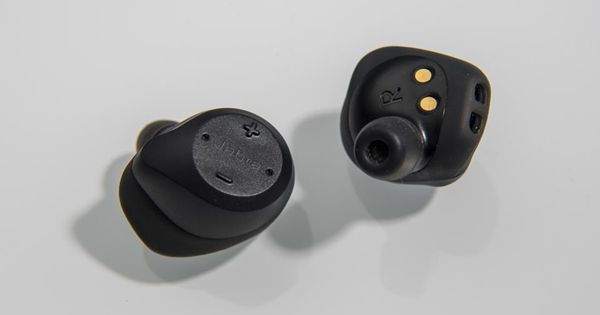
The term hearables refers to a hybrid technology which combines the advantages of wearable technology with the form factor and functionality of a headphone. The term hearables surfaced around April 2014, when Nick Hunn wrote about a new class of wearable devices that are worn as conventional headphones and has a $ 5 Billion market by 2018. Hearables are more than just smart-headphones that can play music or help consumers have a conversation over Bluetooth. Hearables have additional biometric, movement, or proximity sensors that can help the smart device gather context about the consumer’s behavior. Also, they may have voice-enabled virtual assistants build into them, that can provide real-time insights to consumers.
The Jabra Elite Sport wireless headphones are arranged for a photograph in San Francisco, California, U.S., on Monday, June 26, 2017. There’s a new generation of wearables just starting to reach consumers, and they take their predecessors’ approach to the natural next step. Based on the data they collect, these devices actually tell you what to do—while you’re exercising or afterward. Photographer: David Paul Morris/Bloomberg© 2017 Bloomberg Finance LP
When Sony Walkman came out in 1979, it revolutionized how people listen to music. By empowering consumers to personalize their playlists, and providing portability and privacy, the Walkman triggered a change in the music industry. Since then Sony’s Diskman in 1984 and Apple’s iPod in 2001 have continued to make listening to music more comfortable, as advances in the electronics manufacturing industry allowed the devices to get smaller with increased battery life and longer playlists.
Eventually, with the advent of internet-connected smartphones and Bluetooth powered headphones, consumers could finally have infinitely long playlists. The audio quality of the first few generations of Bluetooth headphones was reduced due to sawing off the bottom-end and amplifying the highs and mids. Bluetooth headphones have come a long way since then. The Bose SoundSport are Bluetooth headphones designed for intensive workouts and have added features such as slip-resistance, water-resistant, and 6-hour battery life. The Bose QuietComfort 35 Wireless Noise-Cancelling Headphones have advanced noise-canceling features, and can be integrated with virtual assistants like Alexa or Siri and has 20-hour battery life. The Beats® Studio3 Wireless Over-Ear Headphones have advanced noise canceling feature and 22-hour battery life.
The final iteration of these Bluetooth headphones are hearables that augment the handsfree Bluetooth audio capabilities with sensors and virtual assistants. Hearables are well positioned for competing with wristband based wearables in impacting the health care industry. Here are five ways in which hearables can change health care pathways.
1. Hearables can measure heart rate
Hearables can have built-in optical sensors to measure heart rate. The first hearable to do this was iriverON Bluetooth headphones in 2013. Heart rate tracking is now a feature available in all major headphone brands such as Jabra Sport Pulse™, Huawei R1 Pro, SMS Audio Biosport, the Sony B-Trainer, the LG HR Earphone. Most of these brands co-developed their biometric sensor with Valencell, a US-based company that develops biometric sensor technology for hearables. The ability to continuously measure the consumer’s heart rate both during rest and exercise will help physicians monitor the cardiovascular health of the consumer, and deliver better care for both chronic and acute cardiovascular conditions.
An attendee wears a pair of Google Inc. Pixel Buds wireless headphones during a product launch event in San Francisco, California, U.S., on Wednesday, Oct. 4, 2017. Google unveiled the second generation of its own devices along with an array of entirely new gadgets, plowing the company deeper into a competitive consumer hardware market. Photographer: David Paul Morris/Bloomberg© 2017 Bloomberg Finance LP
2. Hearables can detect fall
Hearables can in principle be more than just Bluetooth headphones, and hearing aids are rapidly adding hearable like functionality. Starkey Hearing Technologies’ new Livio AI hearing aids can do fall detection. They can even do activity tracking and can translate a language in real time. These medical-grade devices will help seniors suffering from hearing losses, to improve hearing as well as detect fall. These hearables will assist patients in tackling multiple health challenges using a single device.
3. Hearables are activity trackers
Vi Sense is a voice-controlled hearable with built-in heart rate and motion sensors. Vi Sense‘s artificial intelligence powered voice can motivate users to achieve their daily goals. Vinchi is a voice-controlled stand-alone hearable that can in addition to playing music, track the consumer’s pace, distance, location, and heart rate. Bragi’s Dash Pro allows consumers to listen to music while automatically tracking physical activity such as heart rate, speed, time, distance and calories burnt. Dash Pro is also waterproof. Products like Vinchi and Dash Pro is already changing the status quo of how consumers enjoy their music while they are running or they are exercising at the gym. By adding the music, hearables are making healthier lifestyle even more fun.
4. Hearables can measure body temperature
Hearables can measure core-body temperature form the ear. Cosinuss’ Degree° is a combination between a wearable in-ear thermometer and an assisting app, that can track body temperature and provide intelligent treatment suggestions. Continuous temperature tracking as offered by these hearables could help pediatricians reliably monitor a child’s health.
5. Hearables as virtual assistants
Hearables can have built-in voice-enabled virtual assistants. With the advent of Apple’s Siri or Amazon’s Echo such conversational virtual assistants are integrated into hearables such as Bragi’s Dash Pro and Livo AI. Also, hearables like Vi Sense and Vinchi have their own voice-enabled virtual assistants that can do a wide variety of tasks from acting as virtual coaches to changing music or telling you your heart rate. Such voice-enabled virtual assistants can serve as caregivers to patients and remind them to exercise, take medication, or visit their physicians.
